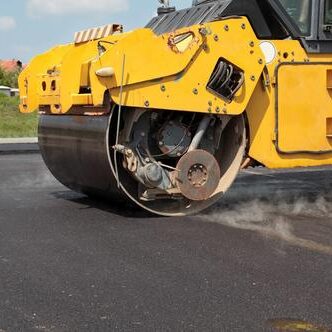Asphalt can be found almost anywhere. From roads to driveways, asphalt has only grown more common over time. Though it is often looked over, asphalt has its own intricate and interesting production process. From the ground to the road, learn how asphalt is made.
From the Ground
Where there’s oil, there’s asphalt. Asphalt cement is a bitumen and a type of crude oil. However, it is much heavier than any oil we use for fuel. Crude oil companies mine it alongside with lighter oils, and asphalt separates into something useful as it is distilled.
During the distillation process, crude oil is filtered into light, medium, and heavy oils. These oils become products such as gasoline, kerosene, and diesel. Asphalt is denser and less viscous than all of these other oils and remains as a byproduct of distilling.
In the modern age, not all of our asphalt comes from crude oil. Asphalt can be from substances such as sugar, molasses, potato starches, and recycled motor oil. However, asphalt from these sources is typically more expensive, and of lower quality than crude oil asphalt.
To the Treatment Process
Asphalt that comes from a distillation plant is nowhere near ready to go onto a road or other paving site. It is nearly impossible to use, requiring extremely high temperatures to make it malleable enough to spread.
To get around this, asphalt production companies cut back the asphalt with lighter oils such as gasoline, kerosene, and diesel — the same products that the asphalt separated from in the distillery. The lighter oils make the asphalt easier to handle and then evaporate away once the asphalt reaches its final destination.
Asphalt curing is the amount of time it takes for these substances to evaporate away. Gasoline makes for fast curing asphalt, while diesel makes the curing process much slower.
To the Road
Even asphalt that is treated and cut back is not quite ready for industrial or residential use. Each load of asphalt must be custom-designed for a project — taking weather and amount of use, along with many other factors, into account.
One of the benefits of asphalt is that it is both strong and flexible. On roads, this is important so that the asphalt can take the constant pressure of vehicles but also withstand freezing and thawing during winter. Since strength and flexibility is usually a trade-off with this type of pavement, pavers must fully study the area before deciding on a perfect asphalt mixture.
Three main types of asphalt are common: hot mix asphalt (HMA), warm mix asphalt (WMA), and cold mix asphalt (CMA). These titles denote how hot the asphalt must be before pouring.
Hot mix asphalt is currently the most common. However, it can be hard to make and pour. HMA is for high-traffic areas, where asphalt needs to be as durable as possible. Cold mix asphalt is for places with less use. It is a lighter color, which means it doesn’t suck in as much heat.
Warm mix asphalt is between the two. It has started to become more common as a replacement for HMA because it is cheaper and easier to use. Still, it is not as durable as its hot mix competitor.
Unlike its oily cousins, asphalt is recyclable. Where lighter oils end their lives in the ozone layer, asphalt can be ripped up and retreated for a new life on a different road or parking lot.
At Arrow Black Top & Masonry, Inc., we offer affordable solutions for your residential and commercial asphalt needs. With our team, you can enjoy a smoother ride while boosting your property’s resale value. You can expect our team to conduct ourselves with professionalism and honesty and to use the latest innovative techniques to improve the look and performance of your paving. Call us today.

